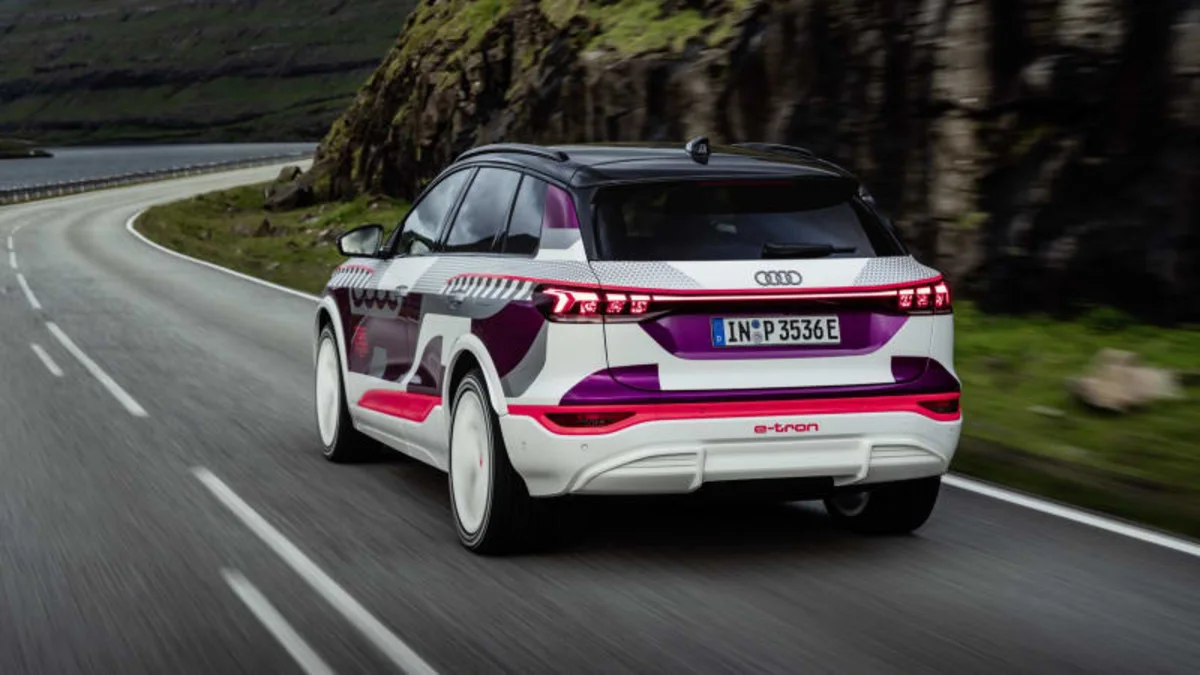FAROE ISLANDS — It’s a bit less punctual than its German heritage would suggest: Audi blew through several proposed launch dates with the new Q6 E-Tron, and it will be next year before it hits dealerships, likely as a 2025 model. Will it be worth the wait? We traveled to the Faroe Islands, halfway between Scotland and Iceland, to find out. Audi invited us here for a “test drive” with two versions of this upcoming, fully electric SUV: the Q6 55 E-Tron, with 396 horsepower, and the SQ6, which makes a whopping 510 horsepower.
The shape of the car is clearly visible, as are many details, as the prototype disguise is limited to white foil with red, pink and purple accents. Standing on 21-inch wheels, shod with 255-section-width-front and 285-rear rubber, the Q6 E-Tron displays sportily chiseled, but ultimately unremarkable lines, with headlights split into an upper and lower part, flanking an octagonal grille. Smaller wheel sizes, from 18 inches upwards, will be available. From behind, the Q6 E-Tron looks like the big brother of the Q4 E-Tron that it actually is. The side view, with a D pillar that resembles a shark fin, looks somewhat coupe-like – although we are told that a Sportback version with a more swoopy roofline will eventually join the regular Q6.

At first glance, this car looks like it was conceived around 2016 and should have been on the market two years ago. But a closer look reveals a lot of smart details. For example, the lighting units: The optional front matrix LEDs don’t just put an icy, automatically adjusted glow onto the road, they can also be configured to show eight different daytime running light patterns. The same number of patterns can be displayed by the rear light clusters, which feature OLED technology. And it can be selected not just on the MMI system, but also on Audi’s phone app, so you can admire your aesthetic choices while standing right next to the car. Audi is understandably proud to reaffirm the leadership it has long enjoyed in lighting technology, with a bitter pill for U.S. customers: Regulation here is so strict that most features will not be available on our shores. You’ll likely have to deal with one factory-selected pattern.
But we will enjoy the modern interior shared with European models. On our test drive, it is largely hidden beneath a plastic veil, but voice commands gave us a hint of next-gen ambient lighting, and the placement of the buttons and controls is as perfect as the tactile feedback. The Q6 features a futuristic four-spoke steering wheel, while the SQ6 comes with a more conventional three-spoke wheel.
But this drive is all about the chassis and powertrain, the actual driving feel of the Q6 E-Tron. It stands on the brand-new PPE architecture, shared with Porsche’s upcoming electric Macan. With a multi-link rear axle and torque vectoring capability, this SUV focuses on dynamics. The steering is quick and precise, the power delivery is rear-biased, the car is remarkably happy to turn into corners and it is even possible to play a bit with the tail on exit. The Q6 E-Tron feels a lot lighter than it actually is, and it’s well-connected and communicates the road surface to the driver. Plus, the brakes can be easily modulated. It is virtually impossible to detect the switch from recuperation to hydraulic braking – in marked contrast to many EVs on the market today. The SQ model is noticeably sportier than the Q6 E-Tron; both versions offer a nice spread between the “Comfort” and the “Dynamic” setting, without moving too much to the extremes.

We appreciate the sheer power and straight-line performance of the Q6 E-Tron, so much so that you might find yourself not needing the extra power of the SQ6 version. In both models, which are ultra-quiet and vibration-free, accelerator response is quick but (thankfully) not as brutal and obnoxious as in a BMW iX. Depending on the model and market, we expect the range to exceed 350 miles – a function of the efficient powertrain and the excellent aerodynamics. There’s a setting for one-pedal driving, and the Q6 is well-prepared for serious off-roading, too.
Its competitive set includes the BMW iX and the Mercedes-Benz EQE SUV; in Audi’s own lineup, the Q6 E-Tron fits exactly between the compact Q4 E-Tron, a twin of the Volkswagen ID.4, and the slightly larger Q8 E-Tron. It is the most harmonious, satisfying electric SUV we have driven so far, and this bodes well for its Porsche Macan sister model, which both Audi and Porsche engineers insist will feature noticeably different driving characteristics. Down the road, there will be an entry-level version with rear-wheel drive only, and on the other end of the market, we expect to see an ultra-powerful RS Q6 E-Tron. Fast is good – especially if Audi finally manages to fast-track this exclusively German-built SUV to the markets as soon as possible.
Read the full article here


